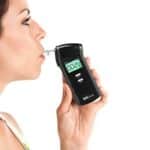Alcohol in Breath: Can It Be Detected?
29 February, 2024

Yes, people can detect alcohol in breath by using a breathalyser. A breathalyser is a device that measures the Blood Alcohol Concentration (BAC) in the breath sample. When someone consumes alcohol, their body absorbs it into the bloodstream, and eventually, they exhale it through their breath. The breathalyser detects this alcohol content and provides a reading. This measurement is crucial for various applications, including law enforcement, to determine if someone is Driving Under the Influence (DUI).
Every year, alcohol impairment causes numerous car crashes and accidents, making it a significant factor. Consequently, police officers conduct roadside inspections to check for sobriety. They use breathalysers to measure the BAC or the percentage of alcohol of the driver. People can also utilise breathalysers for personal use. This article will discuss the technology used in breath testers, including the process of alcohol metabolism and various factors that can impact alcohol detection.
Technology Used to Detect Alcohol in Breath
Detecting alcohol in breath is crucial for various applications, including law enforcement and ensuring workplace safety. One common technology employed in breath analysers is the semiconductor sensor. This sensor detects alcohol molecules in exhaled breath by utilising a semiconductor material. When someone breathes into the device, alcohol interacts with the semiconductor, causing a chemical reaction that alters electrical conductivity. The sensor then measures this change to determine breath alcohol concentration.
Another technology is the fuel cell sensor. This sensor operates through electrochemical oxidation, a process where alcohol molecules in breath react with a porous anode. This reaction releases electrons, generating an electrical current that correlates with the concentration of alcohol in the breath sample. Fuel cell sensors are known for their high accuracy and specificity in detecting alcohol.
Moreover, Infrared Spectroscopy (IR) measures the absorption of infrared light by alcohol molecules in the breath. This absorption pattern is unique to alcohol and allows the sensor to differentiate between different substances present in the breath sample. With their high accuracy, IR sensors are reliable tools for determining the blood alcohol content of an individual.
Advantages of Breath Testing
- Ease of use: it is a convenient and quick way to test for alcohol consumption.
- Non-invasive: Unlike other testing methods, breath testing does not require any needles or painful procedures.
- Immediate results: alcohol breath testing provides immediate results, allowing for quick decision-making and action if alcohol is present.
- Quantitative measurement: alcohol breath tests provide a quantitative measurement of blood alcohol levels.
- Cost-effective: breath alcohol testing devices are a cost-effective method for detecting alcohol impairment.
- Prevention and awareness: breath testing can help raise awareness about the effects of alcohol and prevent accidents and injuries, especially in settings such as heavy machinery operations.

Alcohol in Breath – How Does Alcohol Get Into the Breath?
Alcohol in breath is the result of a natural process called alcohol metabolism. When someone drinks alcohol, their body quickly absorbs it into the bloodstream through the stomach and small intestine walls. Then, it spreads throughout the body via the circulatory system, affecting different organs and tissues. However, the body can only break down alcohol at a certain rate.
As alcohol-rich blood travels through the body, some alcohol molecules make their way to the lungs. The concentration of alcohol in the blood creates a pressure difference, causing some alcohol molecules to evaporate from the blood into the air sacs of the lungs. This process is called diffusion. Once in the lungs, these evaporated alcohol molecules mix with the air that the person breathes in and out.
Breath alcohol testing equipment relies on the connection between blood alcohol content and breath alcohol content. It measures the alcohol in the breath to estimate alcohol levels in the bloodstream. This helps law enforcement officers decide if someone is too impaired to drive safely.
Detection Window
The detection window refers to the timeframe when a breathalyser can spot alcohol in the body. It is the period when the device can accurately pick up the presence of alcohol. Knowing the detection window helps determine how reliable test results are. This is particularly crucial in situations like law enforcement or workplace safety checks.
For breath alcohol tests, the detection is usually short, lasting from a few hours to up to 24 hours after drinking alcohol. But keep in mind, that breathalyser tests are better at spotting recent alcohol intake rather than long-term or frequent drinking.

Factors Affecting the Detection of Alcohol in Breath
Various factors can affect the detection of alcohol in breath. Firstly, the alcohol concentration. Different types of drinks contain varying amounts or doses of alcohol, which can impact the BAC. Factors such as the number of standard drinks and the rate of consumption can also affect BAC.
Secondly, the use of medications. Prescription drugs and other substances can interact with alcohol, leading to an overstatement of the BAC. This can impact the reaction times and ability of the person to function safely, even if the actual BAC might not be as high as indicated.
Thirdly, the stomach contents can play a role in alcohol detection. Having more food in the stomach can slow down the processing and absorption of alcohol, potentially affecting the BAC readings. It is important to note that the elimination of alcohol from the body varies from person to person. Additionally, excess alcohol intake can further complicate the detection of alcohol in the breath. Understanding these factors can help in ensuring accurate and reliable detection of alcohol in the breath.
Individual Differences
Individual differences like body composition, gender, and age can affect alcohol detection in the breath. People who are smaller and have higher body fat may get intoxicated more quickly. Women tend to have more body fat compared to men of the same weight. Hormonal differences between men and women can also affect alcohol metabolism and ethanol analysis.
Another factor to consider is age, as the capacity of the human liver to process alcohol may slow down with age. This can result in a slower determination of blood alcohol levels. Overall, these are some significant factors that can impact the accuracy of breath alcohol testing.
Conclusion
Various technologies such as semiconductor sensors, fuel cell sensors, and IR are used to detect alcohol in breath. These technologies work by measuring the chemical reactions or absorption patterns of alcohol molecules in exhaled breath. Alcohol in the breath results from the natural process of alcohol metabolism, where alcohol in the bloodstream evaporates into the air sacs of the lungs. This connection between blood alcohol content and breath alcohol content allows for accurate estimation of alcohol levels in the bloodstream.
Furthermore, detecting alcohol in the breath relies on various factors including alcohol concentration, medications, and stomach contents. Individual differences such as body composition, gender, and age also play a crucial role. These factors can affect the accuracy of breath alcohol testing, emphasising the importance of understanding them for reliable results. By considering these variables, authorities can improve the effectiveness of alcohol detection methods, ensuring safer environments and better public health outcomes.





























